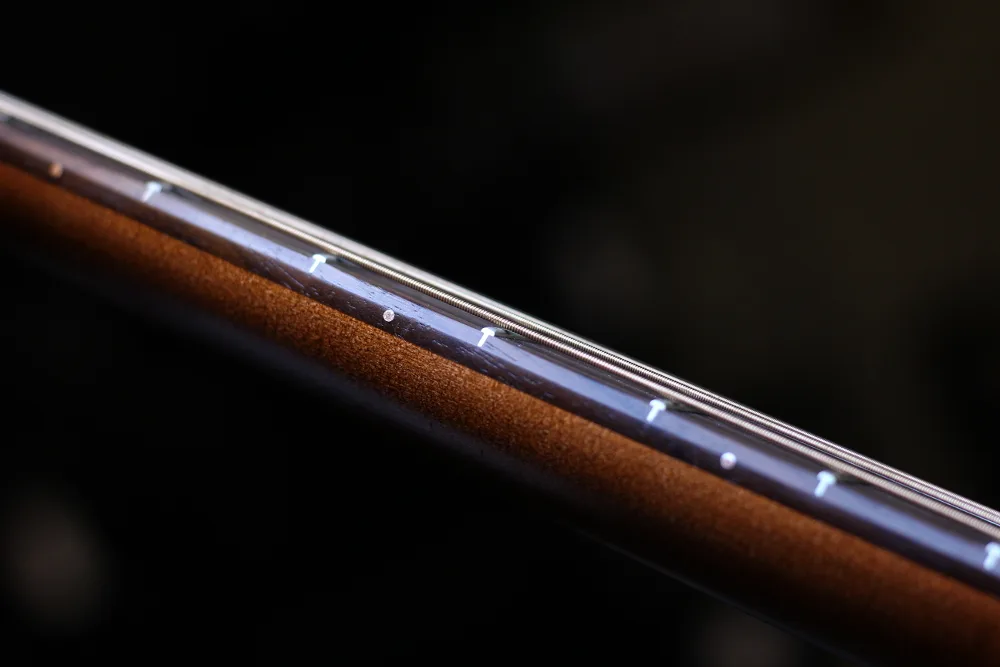Do you love playing your acoustic guitar, but the annoying fret buzz is ruining your jam sessions? I’ve been there- trying to strum away only to be met with that pesky buzzing sound. But fear not, I’m here to help!
In this article, we’ll go over a step-by-step guide on how to fix fret buzz on an acoustic guitar. Whether it’s due to old strings, high action or other factors, I’ve got all the tips and tricks you need to eliminate that unwelcome noise. With my expertise as a guitarist and years of experience dealing with this issue, I’ll share everything you need to know in order to get back to playing without any distractions. So grab your guitar and let’s get started on fixing that frustrating fret buzz!
So, how to fix fret buzz on acoustic guitar?
Fret buzz on an acoustic guitar can be a frustrating issue for any musician. It occurs when the strings vibrate against the frets, creating a buzzing sound instead of a clear note. But don’t worry, it’s actually quite easy to fix! Here is a step-by-step guide to help you get rid of that pesky fret buzz and have your guitar sounding great again.
Step 1: Check Your Strings
The first thing you should do is check your strings. Old or worn out strings can often cause fret buzz. If they look rusty or dull, it’s time to change them.
Step 2: Adjust the Truss Rod
Next, you’ll want to adjust the truss rod on your guitar. This controls the curvature of the neck and can affect how close the strings are to the fretboard. Use an Allen wrench to turn it clockwise if there is too much relief (the middle of the neck bows up) or counterclockwise if there isn’t enough relief (the middle of the neck bows down).
Step 3: Raise The Action
If adjusting the truss rod doesn’t solve your problem, try raising the action on your guitar – this means making more space between your strings and fretboard. You can do this by loosening each string at its bridge saddle with a screwdriver.
Step 4: File Down High Frets
Sometimes, high frets can also cause buzzing sounds when playing certain notes. To fix this issue, take fine-grit sandpaper and gently file down any high spots on those specific frets until they are level with all other ones.
Step 5: Check The Nut Slots
The nut slots may also need some attention if they are too low or unevenly cut. You can use specialized files designed for nut slots or even just fold some sandpaper in half and carefully widen each slot as needed.
By following these simple steps, you should be able to eliminate fret buzz on your acoustic guitar and have it playing beautifully again. Remember, regular maintenance and care for your instrument is key in preventing this issue from occurring in the future. Happy playing!
Understanding the Cause of Fret Buzz on Acoustic Guitars
Fret buzz on acoustic guitars can be a real nuisance, undermining the pure and resonant sound we expect from these instruments. One common reason for fret buzz is incorrect string height or action. If the strings are too low, they’ll touch other frets when played, causing that unwanted buzzing noise. Checking your guitar’s setup becomes crucial here; ensuring that both the neck and bridge are properly adjusted can make a world of difference. Additionally, humidity levels play a role as well—too much or too little moisture in the air can warp the wood slightly, affecting string height.
Another potential cause lies in worn-out frets. Over time, frequent playing wears down certain spots more than others, especially around popular chord positions like G and C major. When this happens, some frets become lower than their neighbors which leads to buzzing when you press those specific areas on the fretboard. Regular maintenance checks help catch such issues early before they escalate into bigger problems requiring extensive repairs or even refretting.
If you’re experiencing fret buzz:
– Check your string action
– Ensure correct neck relief
– Monitor humidity levels
– Inspect for worn-out frets regularly
By keeping an eye on these elements and addressing them promptly will help keep your acoustic guitar sounding its best!
Methods to Adjust String Height for Optimal Tone and Playability
When you’re playing the guitar, getting the perfect string height can make a world of difference. Too high, and it’s like climbing a mountain with each note; too low, and you get that annoying buzzing sound. The sweet spot is where both playability and tone meet in harmony. Firstly, let’s talk about using the truss rod—this metal rod inside your guitar neck helps adjust its curvature. By turning it clockwise, you straighten the neck, lowering action but risking fret buzz if overdone. Turning it counterclockwise adds relief (a slight bow), raising action for cleaner notes but making fretting harder.
Another handy tool in your arsenal is saddle adjustment on an acoustic or bridge saddles on an electric guitar. For acoustics, sanding down or shimming up the saddle can dial in that ideal height. Electrics offer more precision; individual saddle screws allow fine-tuning of each string’s height to balance tone across all strings seamlessly:
- Sanding/shimming: Adjusts overall string action.
- Saddle screws: Fine-tunes individual string heights.
Lastly, never underestimate how crucial regular maintenance is—keeping your frets clean and polished ensures they wear evenly over time.
Combining these adjustments not only improves playability but also enriches tonal quality by ensuring each note rings out clearly without extra effort.
No matter what style you play—from gentle fingerpicking to heavy strumming—a well-set-up guitar feels like an extension of yourself rather than a challenge to overcome.
Read also: how to pick faster on guitar
Replacing Old Strings: A Simple Solution to Remove Fret Buzz
Swapping out old guitar strings can be a game-changer when it comes to eliminating that pesky fret buzz. Over time, your guitar strings wear down, losing their tension and integrity. This wear can cause the strings to sit lower than they should, making them more likely to hit against the frets when you play. It’s like trying to run in worn-out sneakers—you won’t get very far without some discomfort or trouble.
When tackling fret buzz, start by carefully removing the aged strings and replacing them with fresh ones. Make sure you choose the right gauge for your playing style; thicker or thinner strings can drastically affect how your instrument feels and sounds. Once you’ve put on new strings, take a moment to properly tune up your guitar—this is crucial for maintaining good string tension.
- First, loosen and remove each old string one at a time.
- Next, clean any accumulated grime from under where those tired wires once lay.
- Then thread each shiny new string through its respective peg.
- Tighten them steadily while ensuring even tension across all six (or however many) of them.
After you’ve tuned it back up, spend some quality time strumming away or picking single notes gently at first; this will help ensure everything settles nicely without rushing into heavier chord work too soon. Adjusting minor things along the way may also come in handy since every guitar has its unique quirks!

Fixing the Guitar Neck’s Curve: How Truss Rod Adjustment Can Eliminate Frets Buzz
Have you ever played your guitar and heard an annoying buzzing sound? That irritating noise comes from the strings vibrating against the frets. Fret buzz often happens because of a problem with the neck’s curve, and that’s where the truss rod becomes your best friend.
So what is this magical piece of metal inside your guitar called a truss rod? It’s basically a long adjustable rod that runs through the neck. This clever device lets you control how much your neck bends forward or backward. Too much bend either way can cause fret buzz, so finding that sweet spot is crucial. You adjust it using an Allen wrench at either end of the neck, depending on your guitar model.
Fixing fret buzz by adjusting the truss rod isn’t too hard but does require some care:
- First: tune up all six strings to standard pitch.
- Next: gently turn the Allen wrench to tighten or loosen.
- Tightening: straightens out a bowed (upward bent) neck.
- Loosening: adds relief (a slight dip) for better string clearance.
After each small adjustment, retune and check if those pesky buzzes disappear or lessen. Remember, patience pays off—tiny turns are key! By taking these steps carefully, you’ll not only improve playability but also deepen your connection with this beloved instrument.
You may also like: yamaha acoustic guitar fs800
Proper Maintenance Practices to Prevent Future Fret Buzz Issues
One of the best ways to keep your guitar in perfect shape and free from annoying fret buzz is through regular maintenance. A key step involves keeping your instrument clean. Dust and grime can build up on the frets, causing unwanted buzzing when you play. Make it a habit to wipe down the neck with a soft cloth after every session. Occasionally, use a specialized fret cleaner for a deeper clean.
Another critical practice is checking and adjusting the neck relief. Over time, changes in humidity and temperature can cause the wood to warp slightly. This affects how straight or curved your guitar’s neck is, impacting string height and increasing the likelihood of fret buzz. Regularly inspect this by pressing down on one of your strings at both ends of the fretboard simultaneously.
- If there’s too much space between the string and frets: You may need to loosen your truss rod.
- If there’s no gap at all: Tightening might be necessary.
In addition, pay attention to string gauge choices as different gauges exert varying amounts of pressure on the neck. Lighter strings are easier to press but may require more precise adjustments compared to heavier ones that offer resistance but put additional strain on parts like bridges or tuners.
Remembering these small yet significant measures will ensure you enjoy clear tones without any bothersome interruptions!
Conclusion: Mastering the Art of Fixing Fret Buzz on Your Acoustic Guitar
Fret buzz on an acoustic guitar can be incredibly frustrating, especially when you’re trying to play your favorite songs. This annoying sound happens when the string vibrates against a fret instead of just over it. To start fixing it, you’ll need to identify where the buzz is coming from. Check each string and fret individually by playing slowly up and down the neck. Sometimes it’s as simple as adjusting your playing technique or pressing a bit harder on the strings.
Once you’ve found where the problem lies, there are several methods to fix it:
- First, check if your guitar’s neck needs adjustment. A truss rod tweak might do wonders.
- If that doesn’t work, inspect for uneven frets; they may need leveling from a professional luthier.
- Lastly, consider changing your strings or using higher gauge ones for less slack.
Experiment with these solutions one at a time to see what works best.
Fixing fret buzz isn’t always straightforward but mastering this aspect of guitar maintenance will vastly improve your playing experience. Take care in addressing these issues promptly so you can get back to creating beautiful music without distractions. Solving this problem not only enhances tone quality but also boosts confidence in handling minor repairs yourself—turning frustration into mastery!

